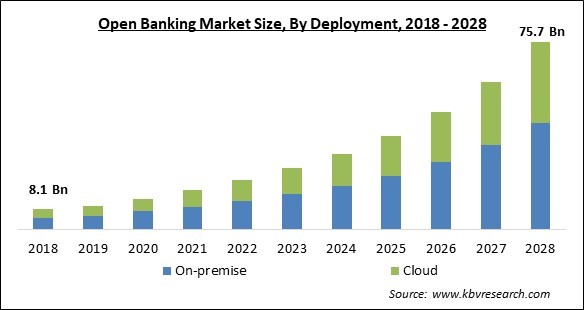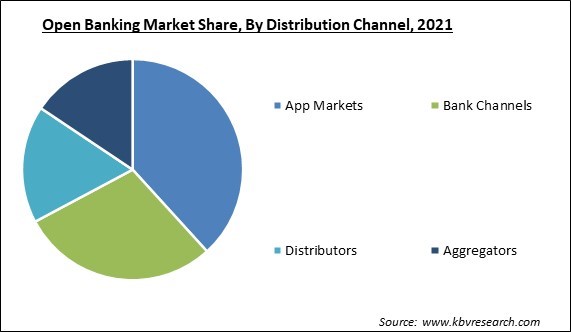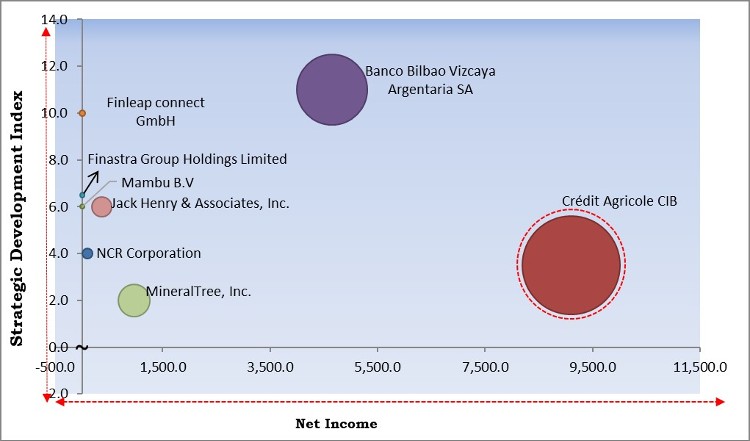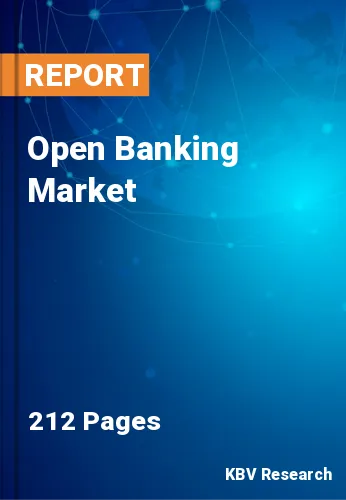The Global Open Banking Market size is expected to reach $75.7 billion by 2028, rising at a market growth of 24.7% CAGR during the forecast period.
Open banking is basically a financial service that enables the electronic sharing of financial data. Additionally, application programming interfaces, also called APIs, are leveraged by open banking services in order to conduct a secure financial data transfer. The interchange of financial data between banks and other service providers is another thing that happens. An open API affords protection to customers' private data, such as the transaction histories and patterns collected by third-party service providers. This enables simple access to publicly available data, such as a bank's product offerings. As a result, the financial data collected about a customer is used to develop sophisticated applications that are intended to enhance the user experience for financial services.

Open bank data is another name for open banking. Through the use of application programming interfaces, the banking practice known as open banking gives third-party financial service providers unrestricted access to consumer transactions, banking, and other financial data between banks and non-bank financial institutions (APIs). Accounts and data from various institutions will be able to be networked for usage by customers, financial institutions, and outside service providers owing to open banking. Open banking is increasingly emerging as a considerable engine of innovation that has the capabilities to transform the banking sector.
Under open banking, banks give third-party service providers, typically software startups or online financial service providers, access to and control over the personal and financial information of their consumers. Customers typically have to give the bank their consent in some way, such as by ticking a box on the terms-of-service window in an online app. The provided data of the client (as well as information about the customer's financial counterparty) can then be used by third-party providers' APIs.
The COVID-19 pandemic outbreak had a significant impact on the market's growth in its initial period. A significant number of companies and their operations were temporarily closed due to the advent of the pandemic. However, the pandemic raised the need for contactless payments, which led to an increase in the need for open banking on a global scale. The COVID-19 pandemic outbreak is anticipated to significantly contribute to an increase in the growth of the open banking market. With the emergence of the pandemic, the banking sector has been developing continuously to enhance the client experience and simplify the banking process for customers. Additionally, a bright future for the market is anticipated as a result of the rising adoption of digitalization.
The financial services industry's whole value chain, including customers, enterprises, Fintech firms, banks, and financial institutions, benefits from open banking. Through the adoption of open banking throughout the sector, a customer in the financial services obtains a greater range of banking services as well as access to cutting-edge and personalized financial products. Because there are several options and service providers to pick from for their financial needs, a customer can benefit from choice.
Applications connected to open banking were developed by banks and third-party service providers to assist users in obtaining consolidated account information from numerous financial service providers. Additionally, using these services and programs makes it easier to manage consumer finances and data. These episodes also provide guidance to viewers on how to better manage their wealth. Digital services via open banking as well as other banking industries improve the customer experience. A significant number of people all over the world use banking applications or the bank's mobile website for banking services. Customers choose new services and applications more frequently as a result, which propels market expansion overall.
One of the major challenges that are impeding the growth of the open banking market is the risk and concerns regarding the privacy and security of the user. Consumers may gain easy access to financial information and services through open banking, and financial organizations may save money by streamlining some costs. However, it might also pose serious hazards to consumer financial security and privacy, as well as general liability for financial institutions. There are security concerns associated with open banking APIs, such as the possibility that rogue third-party software might deplete a customer's account. This represents an extremely remote threat. Therefore, this factor is hampering the growth of the open banking market.
On the basis of Services, the Open Banking Market is segregated into Banking & Capital Markets, Payments, Digital Currencies, and Value Added Devices. In 2021, the banking & capital markets segment acquired the largest revenue share of the open banking market. The segment is anticipated to develop as a result of millennials' rising desire for financial management tools. People's attention shifting from conventional investing approaches to cutting-edge investment solutions is anticipated to open up profitable business prospects for the sector.

Based on Deployment, the Open Banking Market is bifurcated into Cloud and On-premise. In 2021, the On-premise segment procured the highest revenue share of the open banking market. Customers can easily access the on-premise Open Banking, which provides a special way to better meet their demands. The fact that banks and other financial institutions have their own APIs, allowing third parties as well as banks to provide cutting-edge services, is another factor contributing to the segment's growth.
By Distribution Channel, the Open Banking Market is segmented into Bank Channels, App Markets, Distributors, and Aggregators. In 2021, the distributors segment registered a significant revenue share of the open banking market. The growth of the segment is surging at a very rapid pace as a result of the fact that in a distributor model, banks perform the sole job of providing a service or a product by processing what is ultimately sold by a third-party supplier. In this case, the third-party supplier owns the user interface, which is likely to present special chances for the segment's expansion.
| Report Attribute | Details |
|---|---|
| Market size value in 2021 | USD 15.9 Billion |
| Market size forecast in 2028 | USD 75.7 Billion |
| Base Year | 2021 |
| Historical Period | 2018 to 2020 |
| Forecast Period | 2022 to 2028 |
| Revenue Growth Rate | CAGR of 24.7% from 2022 to 2028 |
| Number of Pages | 212 |
| Number of Tables | 364 |
| Report coverage | Market Trends, Revenue Estimation and Forecast, Segmentation Analysis, Regional and Country Breakdown, Competitive Landscape, Companies Strategic Developments, Company Profiling |
| Segments covered | Service, Deployment, Distribution Channel, Region |
| Country scope | US, Canada, Mexico, Germany, UK, France, Russia, Spain, Italy, China, Japan, India, South Korea, Singapore, Malaysia, Brazil, Argentina, UAE, Saudi Arabia, South Africa, Nigeria |
| Growth Drivers |
|
| Restraints |
|
Region-Wise, the Open Banking Market is analyzed across North America, Europe, Asia-Pacific, and LAMEA. In 2021, Europe accounted for the maximum revenue share of the open banking market. The expansion of the regional market can be attributed to the region's growing need for improved online payment security. The government's orders to banks to encourage the opening of APIs are another factor driving market expansion in this region. In addition, the regional market is anticipated to increase as a result of the existence of several prominent companies.
Free Valuable Insights: Global Open Banking Market size to reach USD 75.7 Billion by 2028

The matrix is designed considering the major strategic developments including Mergers & Acquisitions, product launches, partnership among others and the financial strength of the company in the considered years. Companies such as Banco Bilbao Vizcaya Argentaria SA, Jack Henry & Associates, Inc., MineralTree, Inc. are some of the key innovators in Open Banking Market.
The market research report covers the analysis of key stake holders of the market. Key companies profiled in the report include Banco Bilbao Vizcaya Argentaria SA, Finastra Group Holdings Limited, NCR Corporation, Crédit Agricole CIB, Demyst Data, Ltd., Finleap connect GmbH, FormFree Holdings Corporation, Jack Henry & Associates, Inc., Mambu B.V, and MineralTree, Inc.
By Deployment
By Distribution Channel
By Services
By Geography
The global Open Banking Market size is expected to reach $75.7 billion by 2028.
Rising Adoption Of New Services And Applications are driving the market in coming years, however, Privacy Concerns And Risks Related To Data Breaches restraints the growth of the market.
Banco Bilbao Vizcaya Argentaria SA, Finastra Group Holdings Limited, NCR Corporation, Crédit Agricole CIB, Demyst Data, Ltd., Finleap connect GmbH, FormFree Holdings Corporation, Jack Henry & Associates, Inc., Mambu B.V, and MineralTree, Inc.
The expected CAGR of the Open Banking Market is 24.7% from 2022 to 2028.
The App Markets market has acquired the maximum revenue share in the Global Open Banking Market by Distribution Channel in 2021, thereby, achieving a market value of $27.7 billion by 2028.
The Europe market dominated the Global Open Banking Market by Region in 2021, thereby, achieving a market value of $26 billion by 2028.
Our team of dedicated experts can provide you with attractive expansion opportunities for your business.

